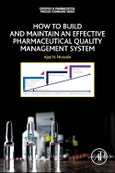Table of Contents
Section I: Why is pharmaceutical quality assurance prone to frequent failures?1. Introduction to pharmaceutical quality in the context of therapeutic outcomes
2. Pharmaceutical quality failures in the 20th century
3. Progress and challenges in moving towards the desired state of pharmaceutical quality in the 21st century
4. Human factors, biases, and blind-spots and science and technology gaps
Section II: What is the 21st Century Pharmaceutical Quality?
5. A new, higher, level of quality assurance
6. 21st pharmaceutical quality, 21st Cures Act & Manufacturing USA
7. Case Example: QMS Considerations for successful launch of a complex generic product
Section III: How to build and maintain an effective Pharmaceutical QMS
8. Remediating an existing QMS: After negative regulatory outcome
9. Effectiveness Assessment of an Existing QMS: Preventing a negative regulatory outcome
10. Ceasing dependence on external regulators: Culture of Quality








